The Story of “Pierced Hemisphere”
Categories: Life As A Composer
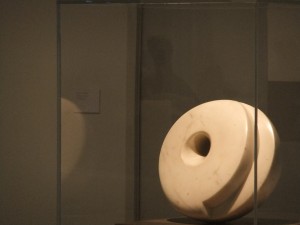 I was commissioned by the Hepworth Gallery, Wakefield in 2011 to compose some music inspired by an art work in the gallery. The piece was to be accompanied by activities and commentaries as part of the “Handling Collection” – a group of art works created by artists in the learning team for use by visitors with additional needs. Here is some of the commentary I wrote for the users of the collection, regarding my techniques and inspiration for composing this piece inspired by Barbara Hepworth’s sculpture “Pierced Hemisphere”:
I was commissioned by the Hepworth Gallery, Wakefield in 2011 to compose some music inspired by an art work in the gallery. The piece was to be accompanied by activities and commentaries as part of the “Handling Collection” – a group of art works created by artists in the learning team for use by visitors with additional needs. Here is some of the commentary I wrote for the users of the collection, regarding my techniques and inspiration for composing this piece inspired by Barbara Hepworth’s sculpture “Pierced Hemisphere”:
Mood, Inspiration, Non-Musical Aspects
As the main purpose of this composition is to be inspired by art works in the Hepworth, then non-musical aspects play a big role in this piece of work.
While I’ve been getting to know the works of Barbara Hepworth and the gallery itself, I have been increasingly fascinated by the circular works of Hepworth with holes in them. I was particularly interested in Pierced Hemisphere, Pelagos and Sphere with Inside and Outside Colour, but as time went on I honed in on Pierced Hemisphere, partly because it was the only one of the three that the curators could guarantee would be there for the opening and for some time after that, and partly because its elements of simple colour, piercing, hemisphere and that ‘bit cut out down the side’ sent my mind a-thinking.
Much of my recent work is for singers, either in choirs or for children. I felt that the brief for this work dictated that what I produce should be in some ways indicative of my usual work. Usually I start with words, then a melody or tune, put chords around it, then either teach it to the singers as it is or add increasing complexities depending on who is performing or listening to the piece. So I needed some words. These occurred to me over time as I came to the gallery and got to know its immediate area and the building itself. I’m told that when it rains the concrete of the Hepworth building becomes purple. I like this idea, although I haven’t seen it for myself yet, as it’s usually cloudy or sunny, but never rainy when I visit Wakefield. 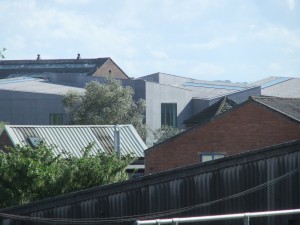 I like that the gallery sits amongst buildings from different eras – the water mill, the larger mills and warehouses of the industrial era, and the Medieval Chantry Chapel on the bridge outside. I think that Pierced Hemisphere looks a bit like a fossil, but know that marble doesn’t have fossils in it. I think it looks like one of those rough, non-descript stones that when chipped open is found to contain magical crystals , but instead it has a hole right through it and the beginning of a spiral. I like that the hole through it at once casts shadow and light. It also makes me think of some sort of science fiction device for teleporting between time zones – find the other half, slot them together, and who knows what might happen.
I like that the gallery sits amongst buildings from different eras – the water mill, the larger mills and warehouses of the industrial era, and the Medieval Chantry Chapel on the bridge outside. I think that Pierced Hemisphere looks a bit like a fossil, but know that marble doesn’t have fossils in it. I think it looks like one of those rough, non-descript stones that when chipped open is found to contain magical crystals , but instead it has a hole right through it and the beginning of a spiral. I like that the hole through it at once casts shadow and light. It also makes me think of some sort of science fiction device for teleporting between time zones – find the other half, slot them together, and who knows what might happen.
I found this rock near the white, bustling stream,
Smooth and round, nestling in purple blocks.
Impossible fossil,
Spiralled scratchline,
Light-holding shadowy eye.
Is it ancient or modern,
Lying left of plainchant and right of industry?
Pitch.
Pitch is just about which notes to use. A melody or tune is how they fit together one after the other, and harmony is about how the notes relate to each other when you play them at the same time in chords. Harmony is also about what key the music is in. This piece is generally in a feeling of C minor, but veers off from time to time, such as just before the flugel horn enters.
As I said before, I usually then write a melody, so that’s what I did.
Example 1 melody with simple harmonic structure
That’s me just singing and playing some chords on the piano. The chords are a simple pattern which repeats four times, once for each phrase of the song. By organising the melody around these repeating chords, then each of the four phrases of the melody fit together. This is what you need to do to compose a round. I’ll persuade the computer to do this so you can hear how this tune can be a round.
Example 2 melody as a round.
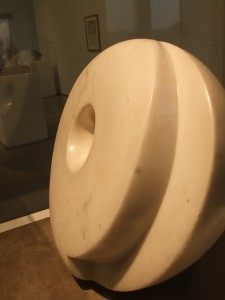 Circles.
Circles.
I considered how to represent circles in music. My first thought, as I said was to create a round (or canon). Although I like the way this works as a round, I didn’t think it was right for this piece. I wanted more space between events. I also thought that the simple chord pattern was a bit too simple – it would be good for children, but not for this more grown-up space and audience. However, I really like the repeating melodic ideas, and the cumulative effect, and use some of these ideas in the finished product.
I was fascinated more by the bit cut out of the circle. It made me think of the beginning of a spiral, so my techniques for developing the melodic ideas which first appeared in my round are spirally, with little bits of melody gradually unravelling (in the choir parts) into a complete tune (the “voices” part).
This voices part is simpler than the spirally melody, but has a more complex chord structure. It uses many of the same melodic shapes and rhythms, but with no repetitions. I imagine that this melody could be performed by anyone. I was inspired in this idea by the Canatas of Bach in which he uses simple hymn tunes that the congregation would know, but has more complex music, based on aspects of the hymn tune dancing around it. It’s also a technique used by Benjamin Britten in “St. Nicholas”.
Example 3 “Voices” melody with chord pattern
Rhythm.
“The sound of a mallet or hammer is music to my ears, when either is used rhythmically, and I can tell by sound alone what is going on……..My left hand is my thinking hand. The right is only a motor hand. This holds the hammer. The left hand, the thinking hand, must be relaxed, sensitive. The rhythms of thought pass through the fingers and grip of this hand into the stone. It is also a listening hand. It listens for basic weaknesses or flaws in the stone; for the possibility or imminence of fractures.” Barbara Hepworth: A Pictorial Autobiography, Bath, 1970, p. 79 (extended edition published 1978 and subsequently reprinted in 1985 and 1993).
I like the idea of Hepworth carving to an internal rhythm. Rhythm is important to me in my own music too. I like changing time signatures (where the groupings of beats is uneven) and additive rhythms (where the beats are of different lengths). In this piece I have slowly set up a steady rhythmic pattern using the stones (eight even beats, then two longer beats), the regularity and repetitiveness of this pattern paying homage to Hepworth’s carving rhythms, and the slight irregularity of it satisfying my own rhythmic quirks. Just like the melodic material, this pattern is gradually unravelled in the first part of the piece, and dismantled again towards the end.
Example – “stones” rhythms during middle section
The hole through the sculpture set me thinking about musical equivalents, and the two recurring themes which crop up are the use of silence in music to create space, tension and moments of rest; and the opening up of the sculpture to reveal its context, to let the light in, to see the inside.
I have used silence in this piece to create tension initially between my fragments of melody and rhythm. It is part of the unravelling process. The silences become less frequent as the fragments of music come together. There are also silences towards the end of the piece. These serve to bring the structure of the music full circle, but also provide some rest after the garnering of activity and sounds through the central section of the work.
As the unravelling reaches its end, the light beaming through the eye casts a different harmonic shadow over the piece, with new notes, new melodic ideas, and also a new sound – the flugel horn. Meanwhile, memories of the first section of the piece are apparent in the “Voices” tune and also in the chords of the choir. We see these fragments of music in a new light and we see the inside of the music.
Timbre
I have scored this piece for 4-part female chorus, flugel horn, stones, gong.
As I said before my use of singers reflects my own recent work so I went for singers again, female voices for the choir. I think that the “voices” part could be sung by any available voices: male voices, children’s voices, or another part in the choir.
All my life I have loved the sounds of the brass band, particularly those warm sounds of its middle registers. These sounds remind me of my own childhood in Worksop, and as I get to know Wakefield, I feel there are similarities between the two towns as they emerge from the damaging closures of their main industries, and wanted to reflect this with one of those poignant, mellow sounds.
Pierced Hemisphere is made of marble and is round like a gong. I wanted to use the sounds of stones, rounds things rolling, and also a more resonant sound to reflect the object itself.
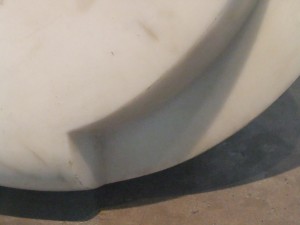 Texture
Texture
I wanted the texture of this piece to help me with the unravelling of the melodic and rhythmic patterns, and also with important moments in the piece. For instance, when the flugel horn enters, all other music stops, leaving the flugel horn on its own – this is an example of monodic texture (just one line of music), and in the context of the thicker choir texture, is quite dramatic musically. Prior to this the choir parts gradually become more polyphonic (this is a type of texture where lines of music weave around each other) as the melodies unravel. All the choir parts are of equal importance, in terms of creating the overall feel of the music. The stones parts provide background music to this unravelling highlighting particular beats and gradually building up the rhythmic momentum. In this opening section of the piece (up to the entry of the flugel horn) I also use some monophonic texture – this is where all the voices sing the same music, get slightly out of synch with each other and then come back together. Here’s a good example – note particularly on the word “stream”.
I really like this sort of texture and have used it quite a bit lately. My other current favourite texture can be heard at the end where the three choir parts are singing in unison (the same notes at the same time), but on significant words they open out into a chord, then come back together again. I don’t know if this sort of texture has a name – I don’t know it, but you can hear it in the last phrase of the entire piece.
When the “voices” part enters in the middle, it becomes the main foreground material, the held chords in the choir, the busy stones parts, and the flugel horn provide the background material.
Texture in music is often about foreground and background (like art, I guess). As this middle section wends its way, the background choir and flugel horn become more to the fore, and the “Voices” part blends into the background. This is me trying to reflect the effect of the hole through the middle of this sculpture – we see/hear inside the music, we see/hear what’s on the other side of it.
Structure
Structure in music is about how you put the different bits of music together. I think this piece is in three sections: the “unravelling” section; the “rhythms of thought” section; the “building” section.
 The unravelling section sees all the melodic and rhythmic material appear gradually. It is fragmentary, with lots of silence. It ends with the entry of the flugel horn, as the light is cast from the eye at the centre of the spiral.
The unravelling section sees all the melodic and rhythmic material appear gradually. It is fragmentary, with lots of silence. It ends with the entry of the flugel horn, as the light is cast from the eye at the centre of the spiral.
The “rhythms of thought” is characterised by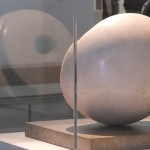 a thicker texture with all forces together throughout. A simple melody occurs three times (Voices part) around which the flugel horn plays a counter-melody (another tune that fits nicely with the main one). The choir gradually develops from long, slow notes, to fragments of the tune again.
a thicker texture with all forces together throughout. A simple melody occurs three times (Voices part) around which the flugel horn plays a counter-melody (another tune that fits nicely with the main one). The choir gradually develops from long, slow notes, to fragments of the tune again. 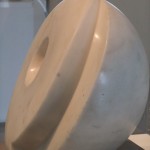 The two stones parts sustain a steady rhythmic pattern throughout.
The two stones parts sustain a steady rhythmic pattern throughout.
The “building” section begins with “Is it” and a silence, plunging us straight back into the mood and music of the “unravelling”. The words here deal with the Hepworth building as it sits between the ancient and the not-quite-so-old. “Lying left of plainchant….” – this section is like a coda, or tail at the end of the piece.
Structure in music is also about where the climax of the piece, or the most exciting or dramatic moment is. When you look at a painting or sculpture. Your first impression is generally of the whole thing, then as you look further and longer, and from different angles, more details become apparent. In music, because it is a time-related rather than a space-related art form, you cannot do this. You do not have an overall impression until you have heard the whole thing. When I looked at this Pierced Hemisphere, I firstly noticed the eye, the piercing. Maybe this is the focal point of the work, at least in my eyes. If you have the focal point of a piece of music at the very beginning, then the rest of the piece is an anti-climax. I have aimed towards the climax of my Pierced Hemisphere music coinciding with the “eye” lyrics, and have marked this moment with the end of the unravelling, the entry of a new timbre (flugel horn), a change in texture (to monody, or one sound), and a change in harmony ( I use a selection of new notes).
I then build to a second, lesser climactic point with the words “is it”, and achieve this with a gradual increase in complexity and activity up to that point and a sudden silence after it.
The recording below was made using a cornet rather than a flugel horn.

No comments yet.